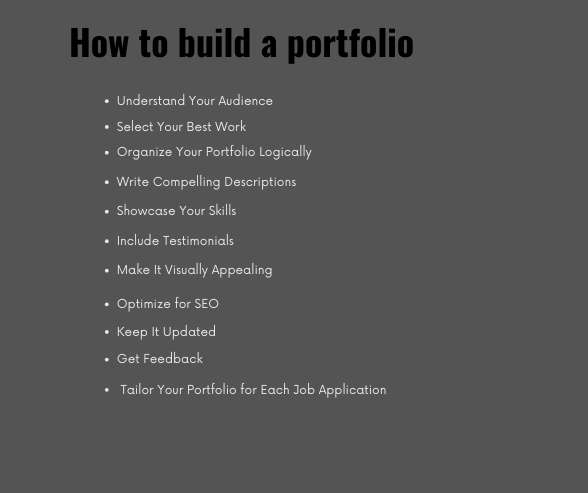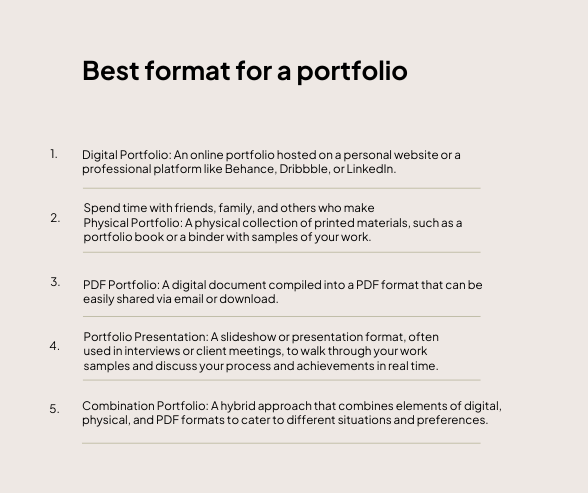Crafting a compelling portfolio for a job application is crucial to showcasing your skills and experience effectively. A well-curated portfolio not only highlights your best work but also demonstrates your suitability for the role you’re applying for. Include diverse examples that align with the job requirements, showcasing your achievements and problem-solving abilities. Ensure clarity and professionalism in presentation, making it easy for employers to understand your capabilities.
What Is A Portfolio?
A portfolio is a curated collection of work that showcases an individual’s skills, experience, and achievements in a particular field. It typically includes samples of completed projects, detailed descriptions of the work involved, and relevant visuals or documents. Portfolios are commonly used by professionals in creative industries such as design, writing, and photography, but they are also valuable in many other fields. They serve as a tool to demonstrate one’s capabilities to potential employers, clients, or collaborators. A well-crafted portfolio provides a comprehensive view of a person’s talents and accomplishments, making it an essential element in job applications and career advancement.
What is the goal of your portfolio?

The primary goal of a portfolio is to effectively showcase your skills, experience, and accomplishments to your target audience, whether they are potential employers, clients, or collaborators. It serves as a tangible representation of your capabilities and expertise in a specific field or industry. A well-organized portfolio should:
- Demonstrate Skills: Display your proficiency and competence through examples of your work.
- Highlight Achievements: Showcase successful projects and outcomes that highlight your achievements.
- Establish Credibility: Build trust and credibility by providing evidence of your capabilities and experience.
- Differentiate Yourself: Differentiate yourself from others in your field by showcasing your unique strengths and talents.
- Facilitate Decision-Making: Help decision-makers assess your suitability for roles or projects based on concrete evidence.
How to build a portfolio

1. Understand Your Audience
Before you start, it’s essential to know who will be viewing your portfolio. Are you targeting potential employers, clients, or collaborators? Understanding your audience will help you tailor your portfolio to meet their needs and expectations.
2. Select Your Best Work
Quality over quantity is the rule here. Choose a selection of your best work that demonstrates your skills and experience. Include projects that are most relevant to the job you’re applying for. For example, if you’re a graphic designer applying for a job in advertising, showcase your best ad campaigns.
Real-World Example:
Jane, a web developer, was applying for a job at a tech startup. She included her most innovative projects, such as a dynamic e-commerce site and a responsive web app, which highlighted her coding skills and creativity.
3. Organize Your Portfolio Logically
A well-organized portfolio is easy to navigate and leaves a positive impression. Start with an introduction or summary, followed by your work samples. Group similar projects together and use clear headings to guide the viewer through your portfolio.
4. Write Compelling Descriptions
Each project should include a brief description that explains your role, the project’s goals, the process, and the outcome. Highlight any challenges you faced and how you overcame them. This demonstrates problem-solving skills and resilience.
Real-World Example:
Mark, a UX designer, included a case study of a mobile app redesign. He described how he conducted user research, identified pain points, and redesigned the app to improve usability, resulting in a 30% increase in user retention.
5. Showcase Your Skills
In addition to your work samples, include a section that highlights your skills and expertise. This can be a list of technical skills, software proficiency, or any certifications you have. Use bullet points for easy readability.
6. Include Testimonials
Adding testimonials from clients or colleagues can provide credibility and build trust. Ask for feedback from those you’ve worked with and include their comments in your portfolio. Make sure to get their permission before sharing.
7. Make It Visually Appealing
Your portfolio should be visually appealing and reflect your style. Use a clean, professional design with consistent fonts, colors, and layouts. Avoid clutter and make sure your work stands out.
Real-World Example:
Sarah, a graphic designer, used a minimalist design for her portfolio, allowing her vibrant artwork to take center stage. She used a consistent color scheme and typography to create a cohesive look.
8. Optimize for SEO
If you’re creating an online portfolio, optimizing it for search engines can increase its visibility. Use relevant keywords, such as “Portfolio for Job,” in titles, descriptions, and throughout your content. Ensure your website is mobile-friendly and has fast loading times.
9. Keep It Updated
A portfolio is a living document that should evolve as you gain more experience and complete new projects. Regularly update your portfolio with your latest work and remove any outdated or less relevant pieces.
10. Get Feedback
Before you finalize your portfolio, get feedback from trusted colleagues or mentors. They can provide valuable insights and point out areas for improvement that you might have missed.
11. Tailor Your Portfolio for Each Job Application
While it might be tempting to use a one-size-fits-all approach, tailoring your portfolio for each job application can make a significant difference. Customize the projects you highlight and the skills you emphasize based on the specific job requirements.
Real-World Example:
Emily, a content writer, customized her portfolio for different industries. For a tech company, she showcased her articles on AI and cybersecurity, while for a marketing agency, she highlighted her copywriting and SEO skills.
What is the best format for a portfolio?

Digital Portfolio: An online portfolio hosted on a personal website or a professional platform like Behance, Dribbble, or LinkedIn. This format allows for easy accessibility, multimedia integration (such as images, videos, and interactive elements), and the ability to update and customize content frequently.
Physical Portfolio: A physical collection of printed materials, such as a portfolio book or a binder with samples of your work. This format is tactile and can leave a memorable impression during in-person meetings or interviews.
PDF Portfolio: A digital document compiled into a PDF format that can be easily shared via email or download. This format is versatile and allows you to control the layout and presentation of your work.
Portfolio Presentation: A slideshow or presentation format, often used in interviews or client meetings, to walk through your work samples and discuss your process and achievements in real time.
Combination Portfolio: A hybrid approach that combines elements of digital, physical, and PDF formats to cater to different situations and preferences.
Conclusion
In conclusion, building a standout portfolio for a job is not just about showcasing your work—it’s about crafting a narrative that demonstrates your skills, experience, and unique strengths to your target audience. By carefully selecting your best work, organizing it thoughtfully, and presenting it in a professional format, you can create a compelling portfolio that leaves a lasting impression. Regular updates and soliciting feedback ensure your portfolio remains relevant and impactful. Whether you’re applying for jobs, seeking freelance opportunities, or aiming to impress clients, a well-crafted portfolio serves as a powerful tool to showcase your capabilities and advance your career. Start building yours today to unlock new opportunities and showcase your professional journey effectively.
